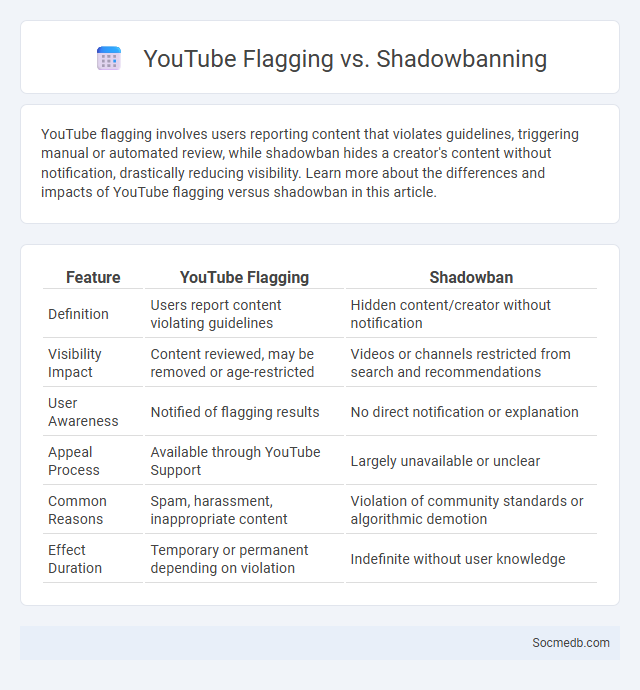
Photo illustration: YouTube Flagging vs Shadowban
YouTube flagging involves users reporting content that violates guidelines, triggering manual or automated review, while shadowban hides a creator's content without notification, drastically reducing visibility. Learn more about the differences and impacts of YouTube flagging versus shadowban in this article.
Table of Comparison
| Feature | YouTube Flagging | Shadowban |
|---|---|---|
| Definition | Users report content violating guidelines | Hidden content/creator without notification |
| Visibility Impact | Content reviewed, may be removed or age-restricted | Videos or channels restricted from search and recommendations |
| User Awareness | Notified of flagging results | No direct notification or explanation |
| Appeal Process | Available through YouTube Support | Largely unavailable or unclear |
| Common Reasons | Spam, harassment, inappropriate content | Violation of community standards or algorithmic demotion |
| Effect Duration | Temporary or permanent depending on violation | Indefinite without user knowledge |
Understanding YouTube’s Enforcement Mechanisms
YouTube enforces its community guidelines through a combination of automated algorithms and human moderators to detect and address violations such as hate speech, misinformation, and copyright infringement. The platform utilizes machine learning models that scan video content, metadata, and user reports to flag potentially harmful or non-compliant material swiftly. Understanding these enforcement mechanisms helps you better navigate content creation, ensuring your uploads meet YouTube's standards and avoid penalties like demonetization or account suspension.
What is YouTube Flagging?
YouTube flagging is the process where users report videos for violating community guidelines such as inappropriate content, copyright infringement, or misinformation. This system enables YouTube to review flagged videos and take actions including removal, age restrictions, or channel strikes. Effective flagging helps maintain platform safety and content quality by empowering the community to identify harmful or misleading videos.
What is a YouTube Shadowban?
A YouTube Shadowban occurs when your videos or comments are hidden or restricted without clear notification, limiting visibility to your audience and reducing engagement. This can result from violations of YouTube's community guidelines, suspicious activity, or algorithmic detection of spam-like behavior. Understanding your channel's analytics and adjusting your content strategy can help mitigate the impact of a shadowban on your YouTube growth.
Differences Between Flagging and Shadowban
Flagging on social media involves users reporting content or accounts that violate platform policies, triggering a review process that may result in content removal or account penalties. Shadowban refers to a covert restriction where a user's posts become less visible or hidden from others without notifying the user, often reducing engagement and reach. While flagging relies on community input to identify inappropriate content, shadowbanning is typically an automated or algorithm-driven action taken by the platform to limit harmful or spammy behavior.
How Content is Flagged on YouTube
Content on YouTube is flagged through a combination of automated systems and user reports, leveraging machine learning algorithms to detect potential violations of community guidelines. YouTube's Content ID system scans uploaded videos for copyrighted material, while viewers and creators can report inappropriate content for manual review. Your flagged content undergoes a thorough evaluation to determine if it breaches policies, potentially resulting in removal, age restrictions, or account penalties.
Signs You’ve Been Shadowbanned on YouTube
Sudden drops in video views, likes, and comments despite consistent posting frequency often indicate a YouTube shadowban. Noticeable restrictions on content discovery through search results or recommendations reflect limited algorithmic visibility. If your subscriber count remains stagnant without typical growth patterns, it suggests your channel's engagement has been suppressed by YouTube's shadowban filters.
Impact of Flagging vs Shadowban on Channel Growth
Flagging content on social media platforms directly alerts moderators to potential violations, often resulting in content removal or account penalties that visibly affect channel credibility and growth. Shadowbanning subtly restricts a channel's visibility without notification, reducing engagement and follower acquisition as content appears less frequently in feeds and search results. Both actions hinder channel growth, but flagging typically triggers immediate corrective steps, while shadowbanning causes prolonged audience reach suppression.
Reasons Your Content Might Be Flagged or Shadowbanned
Content on social media may be flagged or shadowbanned due to violations of community guidelines, such as sharing misinformation, hate speech, or graphic violence. Algorithms also target repetitive behavior, spammy comments, or excessive hashtag use, which can signal inauthentic engagement. User reports combined with automated detection systems increase the likelihood of content suppression to maintain platform integrity and user safety.
How to Appeal Flagging or Shadowban Decisions
To appeal flagging or shadowban decisions on social media platforms effectively, you must first review the community guidelines and identify the specific rule your content allegedly violated. Gather clear evidence demonstrating your compliance with policies, such as screenshots or explanations, and submit a formal appeal through the platform's designated support or help center channels. Your prompt and well-documented appeal increases the chances of reversing restrictions and restoring your account's visibility.
Best Practices to Avoid Flagging and Shadowban on YouTube
Maintain consistent content quality and adhere strictly to YouTube's community guidelines to prevent flagging and shadowbanning. Use accurate titles, descriptions, and tags that reflect your video content to improve visibility and avoid algorithmic penalties. Engaging authentically with your audience through comments and avoiding spammy behavior ensures Your channel remains in good standing.
 socmedb.com
socmedb.com